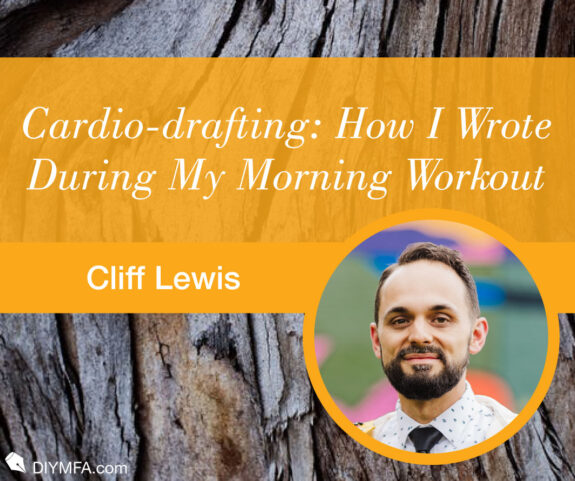I am covered in sweat as I write this, with a heart rate around 150 beats per minute. I’m used to writing this way. In fact, I’ve come to prefer it to the keyboard, the notepad, or any other stock imagery you might find when you Google the word “writing.” This technique helps me write more words in less time with virtually zero distraction or writer’s block. It’s how I drafted my debut novel over the course of a single summer. I call it cardio-drafting.
Like most of the best inventions, cardio-drafting was born out of necessity. I would never have discovered this technique had I not been blindsided by the hook for such an urgent, time-sensitive story. We the Future isn’t just a kids’ novel about the climate crisis. It’s a novel about what kids can do to fight back—how they can organize themselves and apply people power to demand the sweeping systemic changes we’ll need to turn the tide.
From the moment I envisioned the story of a girl from 2100 traveling back to the 2020s on a mission to rewrite history, I knew I had to get this book into the hands of young readers as soon as humanly possible. Time was running out.
Mining for minutes
So I immediately started hydraulic fracturing my schedule, working to squeeze out every last cubic inch of writing time from every available day. I woke before dawn. I wrote over lunch. On a family road trip, I took the passenger seat and wrote at 85 miles per hour. After I’d exhausted every available minute, I found myself greedily sizing up the only un-mined tract of time I had left: My morning workout, which typically consumes between 45 minutes and an hour of each day.
At first, I used that daily jog for some loose brainstorming, just letting my mind explore the edges of the story. But I found myself turning out too many ideas to account for afterward. I needed some way to document my thoughts on the fly. That’s where voice-text came in. When inspiration struck, I would simply pull out my phone, tap that little microphone button on my keypad, and dictate my thoughts while running.
Before long, I had the whole story outlined beat for beat, and it was time to start drafting. And, by this point, I saw no reason to drop my morning routine.
A high-intensity, high-endurance writing schedule
At the risk of sounding like some kind of Men’s Health clickbait about everything Chris Pratt eats in a day to get shredded for Jurassic World 9, I’m going to break it down for you hour by hour. Some ideas are best conveyed in chronological order.
So here’s how my cardio-drafting routine played out every day that summer, until I found myself with a finished (and surprisingly presentable) first draft:
5:00 a.m.
I lurch out of bed, hop into my running shorts, and set out to jog a big loop around my neighborhood. I open the Google docs app on my phone so I can send my words straight into the cloud. From there, I simply write the book with my voice—in between panting breaths.
Most of the time I dictate the prose and dialogue word for word, but whenever I get stumped on the particulars of language, all I have to do is talk out the beat and its intended effect. That usually gets me where I’m going.
No stopping—that’s my only rule. Cardio-drafting is all gas, no breaks.
6:00 a.m. – 7:00 a.m.
By this time, I’ve completed both a morning workout and a good few pages of pre-writing. During this hour, I focus on cleaning up those breathless, pre-written passages. Aside from a good few voice-text miswordings, these pages tend to require a lot less revision than you might think.
12:00 p.m. – 1:00 p.m.
During my lunch break I pick up where I’d left off at seven, this time while slurping down a creatine-infused kale and cod shake. Sorry, I’m slipping into Chris Pratt mode. It’s usually string cheese, almonds, and whatever leftovers I can wolf down between bursts of frenetic typing.
By the end of this session, I’ve usually finished translating my cardio-drafted text into slightly polished, reasonably readable prose.
9:00 p.m. – 10:00 p.m.
After I get the kids in bed, I settle down in front of my outline and review the scenes I’ll be starting the next morning. I crack into the standard Google Doc I’ll use while cardio-drafting and type up some beats and notes-to-self in all caps so I can easily dictate around them when I start my run the next day.
10:00 p.m. – 11:00 p.m.
Binge-watch Curb Your Enthusiasm with my life-bestie until it’s time for bed.
The superhuman side effects of cardio-drafting
For me, this technique was nothing short of miraculous. And not just in terms of efficiency. I found that, while running, I was virtually immune to writer’s block.
I had compiled a killer book-themed playlist on Spotify, which would resume playing anytime I wasn’t dictating into my phone. So, if I ever briefly hit a wall, Peter Gabriel and Lizzo would be standing ready to rally me back to the text. Once I’d found the thread, I would hit that little microphone button and speak the next line.
Cardio-drafting was also a boon to the voice of my first-person narrator and every moment of dialogue throughout the book. I mean, when you’re aiming for organic and conversational, it gets a lot easier when you’re literally speaking your words onto the page.
Another advantage to cardio-drafting is a bit more elusive, harder to define. I’ll do my best. When I ran, there was something about my high BPM that kept my BS detector cranked to 11. Whenever a phoned-in line of dialogue popped into my mind, it felt like every cell in my lungs was raging against it. I was way too winded to waste my breath on a cliche.
On the flip side, whenever I found myself approaching a fresh turn of phrase, I would suddenly feel just a little lighter in my step, like when a great tune makes you feel like you’re walking on air.
While running, it felt so much easier for me to come up with language that legitimately hit the mark, especially compared to the experience of sitting in front of a blinking cursor and the yawning gulf of a blank, glowing screen.
Wherein an English major talks about science
There’s actually a considerable amount of research to back this up. Studies have drawn a strong link between physical activity and the readiness of your mind to enter a state of “flow”—that hyper-focused, unhurried feeling that causes you to strike up so many billion-dollar ideas while you’re standing in the shower. Flow can produce higher levels of joy, curiosity, and creativity.
But exercise can do so much more than summon a flow state. Physical activity has also been linked to higher rates of neuroplasticity (layman’s terms: wibbly wobbly stretchy bendy flexible thinking), neurogenesis (creation of new neurons), and mental focus. That’s right, kids: Focus. So, if you happen to mirror my personal case of undiagnosed adult ADD, a good jog might be just what you need to diffuse those time-killing impulses and get those pages moving.
It may not work for you, but it may work wonders
Maybe cardio-drafting will work for you. But maybe you just can’t see an hour-long workout fitting into your daily routine. That’s okay! I’ve found that dictation alone, even without running, can go a very long way.
I’ve had many a rainy, snowy, or sleepy day when I simply sunk into a comfy chair, muted my notifications, and dictated pages straight into my phone.
It reminds me of how some writers swear by drafting in Comic Sans. We take up habits like these whenever we need an external force to keep ourselves from getting too precious with each individual word-choice.
For me, that force was cardio-drafting. This technique helped me complete an urgent novel just in the nick of time.
You can do it while running, walking, treadmill-ing, or elliptical-ing. If it works for you, great! If it doesn’t, go ahead and salvage whichever parts might help you crank out your draft with minimum distraction and maximum heart.
Which reminds me of one major caveat—especially relevant when you take your morning run in full view of your neighbors: If you ever find yourself cardio-drafting a novel about how your kids’ generation can fight for the future they deserve, you just might find yourself writing and crying while running. Or so I’ve been told.

Cliff Lewis is the author of We the Future, a middle grade novel about what happens when a climate-anxious boy teams up with a girl from the future to launch a climate strike big enough to rewrite history. We the Future releases from Jolly Fish Press on April 18, 2023, just in time for Earth Day.
You can find him on his website or follow him on Instagram and Twitter.







